- cross-posted to:
- electricvehicles
- cross-posted to:
- electricvehicles
The electric vehicle (EV) industry in the United States is revving up, with sales hitting the 4 million mark at the end of June. Tesla continues to lead the charge, accounting for about 61% of the EV market.
This surge is fueled by a mixture of factors such as Tesla’s price cuts earlier this year, tax credits of up to $7,500 for consumers, and an overall increase in manufacturing capacity. It took nearly eight years to sell the first million EVs in the US, which was achieved in 2018. However, the pace has been quickening with the fourth million achieved after just 10 months.
All major players, including Tesla, General Motors, Rivian, and BYD, have reported strong US sales and deliveries for EVs during the second quarter. Tesla’s strong performance, despite being an established player in the EV market, underscores the overall market strength.
Tesla’s reach continues to extend as it plans to open its Supercharger network to other vehicles, including those from Ford, GM, and Rivian. This initiative addresses a significant concern for US drivers - the limited availability of fast public charging. With about 12,000 Superchargers, Tesla represents around 60% of the total fast chargers available to US EV drivers.
Furthermore, Tesla’s consistent discounts have played a key role in driving sales up. Earlier this year, Tesla cut prices across its models, leading to a record delivery of 466,000 cars between April and June. It further reduced prices in March, making its high-end models more accessible.
The EV sales boom has also been supported by the Inflation Reduction Act, part of President Joe Biden’s climate change policy, offering consumers up to $7,500 in tax credits. As Tesla has already sold more than 200,000 EVs, three of its models are eligible for the full tax credit, further fueling its market dominance.
As the electric vehicle market continues to grow, Tesla’s continuous innovations and strategic pricing are making it an undisputed leader in the sector.
deleted by creator

